Bulgaria’s strong house price growth continues
After five years of strong house price rises, Bulgaria’s housing market remains strong, buoyed by low interest rates and a stable economy.
The nationwide house price index rose by 7.29% (3.56% inflation-adjusted) during the year to Q1 2019, following y-o-y rises of 5.54% in Q4 2018, 6.27% in Q3, 7.51% in Q2 and 7.09% in Q1, according to the National Statistical Institute (NSI). During the latest quarter, house prices increased 2.62% (1.42% inflation-adjusted) in Q1 2019.
- Prices of new dwellings rose by 11.9% (8% inflation-adjusted) during the year to Q1 2019, sharply up from the previous year’s 2.3% y-o-y rise. During the latest quarter, prices of new dwellings increased 5.7% (4.4% inflation-adjusted).
- Prices of existing dwellings rose by 5% (1.3% inflation-adjusted) in Q1 2019 from a year earlier, lower than the 9.7% y-o-y growth in Q1 2018. Quarter-on-quarter, existing house prices increased 1.1% (-0.1% inflation-adjusted).
The almost zero interest rates on bank deposits have encouraged people to invest in real estate, and also encouraged purchases of pre-construction residential property.
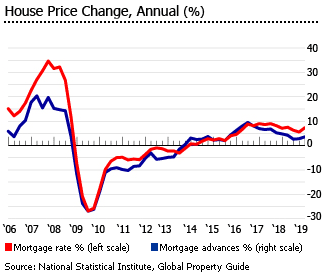
Despite strong demand, construction activity remains low. In the second quarter of 2019, newly built dwellings fell by 1.5% to 2,250 units from the same period last year, following annual declines of 3% in 2018 and 10.3% in 2017, according to the NSI.
From 2000 to 2008, Bulgaria had a house price boom, with residential property prices surging around 300%. The bubble burst at the end of 2008. The housing market started to recover in 2014 and house prices have been rising since.
HOUSE PRICE INDEX, ANNUAL CHANGE (%) |
||
| Year | Nominal | Inflation-adjusted |
| 2009 | -25.72 | -26.14 |
| 2010 | -4.96 | -9.08 |
| 2011 | -5.81 | -8.33 |
| 2012 | -1.30 | -5.33 |
| 2013 | -1.20 | 0.40 |
| 2014 | 2.78 | 3.69 |
| 2015 | 3.98 | 4.37 |
| 2016 | 8.11 | 8.01 |
| 2017 | 8.15 | 5.24 |
| 2018 | 5.54 | 2.79 |
| Sources: National Statistical Institute, Global Property Guide | ||
Demand for properties in the major cities continues to grow, and supply is increasingly limited by low levels of new construction.
“The shortage in the supply of completed projects continued during the [first half of 2019]. As a result, 60% of the residential units under construction were pre-sold,” said Colliers International.
Bulgaria’s economy is expected to expand by 3.3% this year and by 3.4% in 2020, after expansions of 3.1% in 2018 and 3.8% in 2017 and annual average growth of 1.2% from 2009 to 2016, according to the European Commission.
European Union citizens can purchase properties in Bulgaria, including land. Before January 2012 foreigners could purchase land only in the name of a legal entity and were not allowed to own a property.
Local house price variations
All Bulgaria’s major cities saw robust house price rises during the year to Q1 2019.
- Sofia, Bulgaria’s capital, saw an overall house price increase of 9.5% y-o-y in Q1 2019. Prices for new dwellings rose strongly by 18.6% while existing dwellings saw a price increase of 5.3%.
- In Plovdiv, the second largest city in Bulgaria, saw house price rises of 7.1% during the year to Q1 2019. Prices of new dwellings increased by 12.6% while existing dwelling prices rose by 3.9%.
- Varna, the largest city and seaside resort on the Black Sea Coast, recorded an overall house price rise of 4.1% during the year to Q1 2019. Over the same period, prices of new dwellings rose by 1.5% while existing dwelling prices increased 5.5%.
- In Burgas, overall house prices rose by 8% during the year to Q1 2019. New dwelling prices rose by 9.6% while existing dwelling prices increased 5.6%.
- In Ruse, overall house prices rose by 3.3% in Q1 2019 from a year earlier. New dwelling prices increased 4.6% while existing dwelling prices rose by 3.1%.
- In Stara Zagora, overall house prices increased 4.4% y-o-y in Q1 2019. New dwelling prices surged by 9% while existing dwelling prices rose by 2.9%.
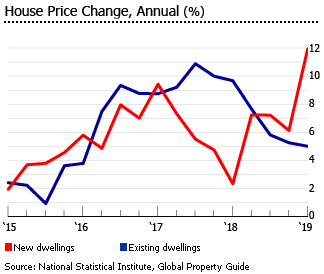
Most sought-after locations in Sofia
Sofia, Bulgaria’s capital city, remains one of the most preferred locations in the country. In H1 2019, the average sales price ranged from €145,000 to €180,000 for two-bedroom apartments and from €210,000 to €250,000 for three-bedroom apartments, according Colliers International. Prices of houses start at €450,000.
Sofia’s Southern districts are currently experiencing strong interest from both locals and foreign buyers. In Lozenets and the city center, demand remains high despite that fact that these locations have the highest property prices in the country, ranging from €1,500 to €2,000 per sq. m. Strelbishte and Gotse Delchev are also preferred neighbourhoods with property prices between €1,100 and €1,400 per sq. m.
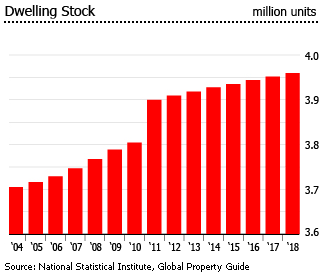
The Krastova Vada and Hladilnika districts, particularly along the Cherni Vrah Boulevard and around the Paradise Center shopping mall, are also popular because of their amenities, trade centres, improved infrastructure, proximity to Vitosha Mountain and the future opening of metro stations. The average residential property price in Kraskova Vada currently stand at about €1,200 per sq. m.
Other districts in demand include Studentski Grad and Vitosha because of the availability of newly-built homes at affordable prices. The average price of dwellings in Vitosha is currently at €1,100 per sq. m. while it is €1,000 per sq. m. in Studentski Grad. Manastirski Livadi, Mladost and Vrabnitsa districts are also popular with average house prices ranging from €800 to €1,100 per sq. m.
In Sofia, there were 5,641 property sales in Q1 2019, up slightly from a year earlier, according to the Registry Agency.
Ski resorts led sales growth
Bansko in southwestern Bulgaria, gateway to numerous ski and snowboard slopes on Todorka Peak, saw double-digit increase in property transactions during 2018.
The other two big ski resorts in the country, Pamporovo and Borovets, also recorded strong increases in sales volumes of at least 10% in 2018 from a year earlier.
“This shows that the ski resort property market in Bulgaria is already active all-year-round, and during the summer months there is a particularly high demand for property to buy,” said Polina Stoykova, the Executive Director of Bulgarian Properties.
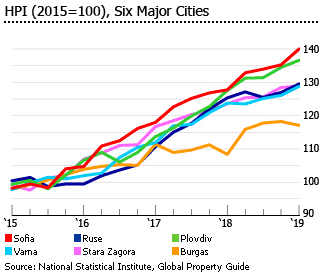
“The main reasons for the increasing attractiveness of the properties in the ski resorts are the attractive prices on one hand, which are the best in Europe, and on the other hand - the improving infrastructure, the easy and fast access from the big cities, the accumulated experience in the management and maintenance of the complexes and above all - the ski resorts in Bulgaria have turned into all-year-round resorts,” Stoykova added.
Only about 40% of property buyers in Bansko are Bulgarians and the rest are foreigners. This is in contrast to Borovets and Pamporovo where almost all buyers are Bulgarians who live in Sofia and other major cities.
Investors are looking for investments that provide capital gains and rental returns. Holiday homes in ski resorts are now considered attractive as rental income investments. Most properties are purchased for cash.
Construction still way below peak, and falling
From 2005 to 2011, 16,700 dwelling units were completed every year. Construction peaked in 2009 when dwellings completed exceeded 22,000 units. However completions then fell sharply, and in 2018 only 8,136 units were built - a similar low level to previous years since 2010.

In the second quarter of 2019, newly built dwellings fell by 1.5% to 2,250 units from the same period last year, following annual declines of 3% in 2018 and 10.3% in 2017, according to the NSI. Likewise, dwelling starts also dropped 8.8% y-o-y to 5,650 units in Q2 2019.
Interest rates continue to fall
The average mortgage interest rate for BGN-denominated loans fell to a record low of 3.09% in July 2019, from 3.38% in a year earlier, according to the Bulgarian National Bank. Similarly, the average mortgage rate for euro-denominated loans also fell to a record low of 3.34% in July 2019, from 3.72% a year ago.
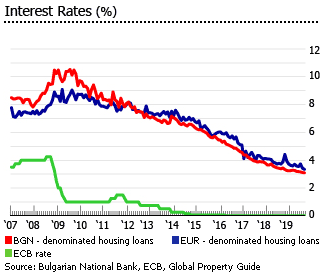
For BGN-denominated loans, in July 2019:
- Interest rate fixation (IRF) of up to 1 year: 3.09%, down from 3.38% a year earlier
- IRF over 1 and up to 5 years: 2.82%, slightly down from 2.88% a year ago
- IRF over 5 and up to 10 years: 3.59%, slightly up from 3.51% a year ago
- IRF over 10 years: 3.4%, down from 3.6% a year earlier
For Euro-denominated loans, in July 2019:
- IRF of up to 1 year: 3.3%, down from 3.64% a year earlier
- IRF over 1 and up to 5 years: 5.04%, up from 3.53% a year earlier
- IRF over 5 and up to 10 years: 3.03%, down from 3.81% a year ago
- IRF over 10 years: 5.01%, down from 5.93% a year ago
Small mortgage market
Bulgaria’s mortgage market is now showing signs of improvement, after several years of decline. In July 2019, there were about BGN353 million (€180.5 million) new housing loans drawn, up almost 32% from the same period last year. More than 94% of the new housing loans are BGN-denominated loans, with IRF of up to 1 year.
Total outstanding housing loans increased strongly by 11.8% to BGN 11.13 billion (€5.7 billion) in Q2 2019 from the same period last year, according to the Bulgarian National Bank.
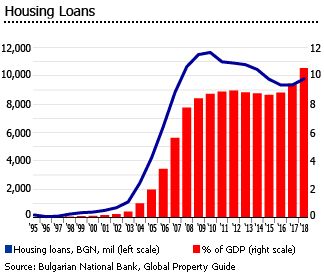
In 2018, the size of the mortgage market expanded slightly to 9.8% of GDP, up from 9.4% of GDP in 2017 but still down from 11.7% of GDP in 2010.
The mortgage market experienced massive expansion during the boom years from just 0.38% of GDP in 2000.
Rental yields are moderately good
Sofia has moderate to good gross rental yields - i.e., the rental return on a property if fully rented out, before all expenses. Yields in the centre were around 6% in 2018, almost unchanged from a year earlier, based on recent Global Property Guide research. Yields a little further out are similar.
Doctor’s Garden, Ivan Vazov, Iztok and Lozenets are among the most sought after addresses in the centre. Embassies, museums and universities are located here. These areas also have many parks and green spaces, making them popular with expats.
In the southern part of Sofia in Vitosha Mountain (or in the vicinity) are prestigious suburban neighborhoods like Boyana and Dragalevtsi. Though new developments being built here are increasing the stock of rental apartments, we find better yields here on the very smallest apartments, with yields stretching up to 6.4%.
The Global Property Guide was not able to provide yields in Bulgaria’s beach and ski areas, because rents in these areas are highly seasonal.
Transaction costs in Bulgaria are moderate, and more or less evenly split between buyer and seller.
In H1 2019, the average monthly rent ranged from €950 to €1,200 for two-bedroom apartments in Sofia and from €1,300 to €1,600 for three-bedroom apartments, according Colliers International. Rents for houses start at €2,000 per month.
Robust economic growth, improving finances
In Q2 2019, Bulgaria’s economy expanded by 3.5%, following y-o-y growth of 3.5% in Q1 2019, 3.2% in Q4 2018, 3.1% in Q3 2018 and 3.4% in Q2 2018, according to the NSI.
In Q2 2019:
- Domestic consumption rose by 2.6% y-o-y, following a 4.5% growth in Q1 2019
- Gross fixed capital formation rose by 2.2% y-o-y, slightly down from 2.5% growth in the previous quarter
- Exports increased 3.7% y-o-y, down from a 5.1% rise in Q1 2019
- Imports fell by 2% y-o-y, in contrast to a 3.9% increase in the previous quarter
Bulgaria’s economy is expected to expand by 3.3% this year and by 3.4% in 2020, after expansions of 3.1% in 2018 and 3.8% in 2017 and annual average growth of 1.2% from 2009 to 2016, according to the European Commission.
The country recorded a budget surplus of 2% of GDP in 2018. It was the country’s third consecutive year of budget surplus since 2008. During the first half of 2019, the country recorded a budget surplus of BGN3.23 billion (€1.65 billion), equivalent to 2.8% of this year’s estimated GDP.
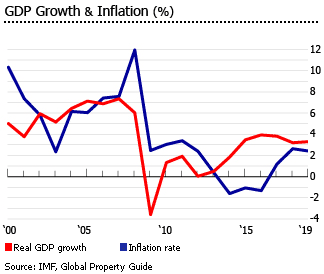
Inflation was 2.9% in August 2019, unchanged from the previous month but down from 3.5% a year earlier, based on figures from the NSI. Consumer prices are expected to increase by about 2.4% this year, after inflation of 2.6% in 2018 and 1.2% in 2017 and deflations of 1.3% in 2016, 1.1% in 2015 and 1.6% in 2014, according to the IMF.
Unemployment stood at 4.2% in Q2 2019, down from 5.5% a year earlier, according to the NSI. Unemployment is expected to fall to 5% this year, the lowest level since 1990, based on IMF projections.
Sources:
- Residential Market Overview H1 2019 (Colliers International): https://www2.colliers.com/en-BG/Research/Residential-Market-Overview-H1-2019
- 17.06.2019 The Residential Market in Sofia in Q1 of 2019 - Increased Activity and Unchanged Prices (Bulgarian Properties): https://www.bulgarianproperties.com/Newsletter_archive/housing-market-sofia-1Q2019_471.html
- Newly built residential buildings and dwellings completed in the second quarter of 2019 (Preliminary Data) (National Statistical Institute): https://www.nsi.bg/sites/default/files/files/pressreleases/New_Dwellings2019q2_en_YTYE673.pdf
- Short-term Business Statistics (National Statistical Institute): https://www.nsi.bg/en/content/6797/short-term-business-statistics
- Macroeconomic Statistics (National Statistical Institute): https://www.nsi.bg/en/content/11236/macroeconomic-statistics
- Statistics on Deposits and Loans by Amount Category and Economic Activity, 2019 (Bulgarian National Bank): http://www.bnb.bg/Statistics/StMonetaryInterestRate/StDepositsAndCredits/StDCQuarterlyData/index.htm?forYear=2019
- Interest Rate Statistics (Bulgarian National Bank): http://www.bnb.bg/Statistics/StMonetaryInterestRate/StInterestRate/StIRInterestRate/index.htm
- Economic forecast for Bulgaria (European Commission): https://ec.europa.eu/info/business-economy-euro/economic-performance-and-forecasts/economic-performance-country/bulgaria/economic-forecast-bulgaria_en
- World Economic Outlook Database (International Monetary Fund): https://www.imf.org/external/pubs/ft/weo/2019/01/weodata/index.aspx
- Rental yields are moderate in Sofia, Bulgaria (Global Property Guide): https://www.globalpropertyguide.com/Europe/Bulgaria/Rental-Yields
- Bulgaria H1 2019 Budget surplus at 3.23B leva (The Sofia Globe): https://sofiaglobe.com/2019/07/31/bulgaria-h1-2019-budget-surplus-at-3-23b-leva/
- Main Labour Force Survey Results, Second Quarter of 2019 (National Statistical Institute): https://www.nsi.bg/sites/default/files/files/pressreleases/LFS2019q2_en_Q67SLNV.pdf
- Bulgaria records 0.6% economic growth in Q2 2019 – flash estimate (The Sofia Globe): https://sofiaglobe.com/2019/08/14/bulgaria-records-0-6-economic-growth-in-q2-2019-flash-estimate/
- Bulgaria GDP Q2 2019 (Focus Economics): https://www.focus-economics.com/countries/bulgaria/news/gdp/economy-maintains-momentum-in-q2